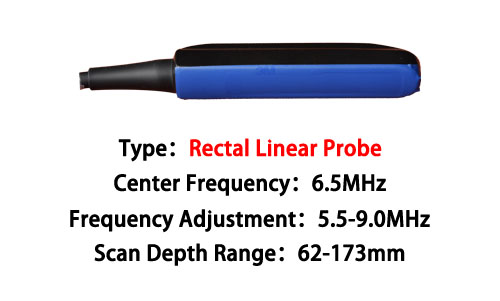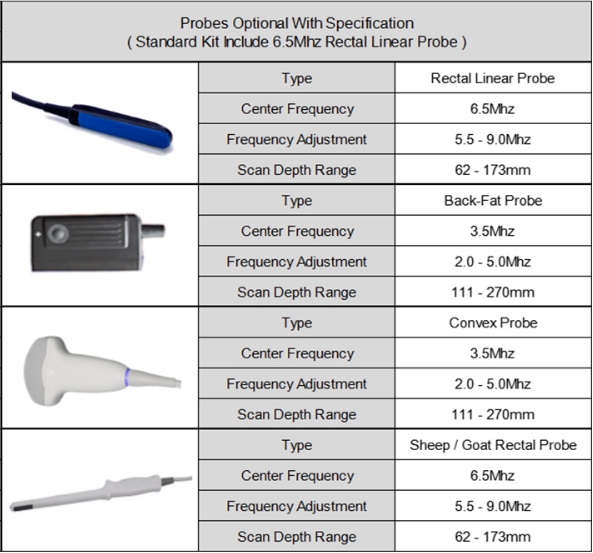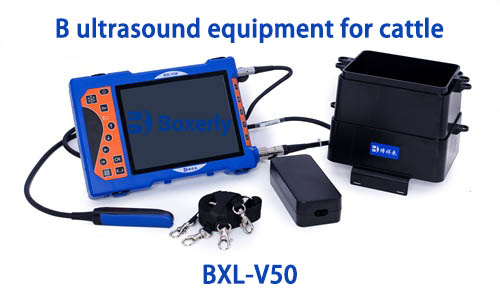Если вы провели время на животноводческом предприятии, you’ve probably seen ultrasound machines used to check animals—but have you ever wondered how that long, Палочкообразный зонд на самом деле работает? Сегодня, let’s talk about rectal ultrasound probes and which animals they’re best suited for.

Rectal Linear Probe
How Probe Choice Varies by Animal
The size and anatomy of the animal directly influence which type of probe is most effective. For large animals like cattle and horses, many internal organs—especially reproductive organs—are located deep within the abdomen. A standard convex probe applied externally often isn’t able to reach or clearly image these deeper structures. It’s a bit like trying to inspect a dark corner of a room with a flashlight from across the hallway—you just won’t see much. Rectal probes, on the other hand, are inserted directly into the rectum and scan right up against the uterus or other reproductive organs, providing much clearer and more accurate imaging.
Medium-sized animals like Свиней and sheep are built differently. Their abdomens are shallower, so external convex probes can often provide clear enough imaging without needing to go internally.
Practical Use of Rectal Probes on the Farm
There are two main types of rectal probes: linear array and convex array. Linear probes offer very high-resolution images but typically have a shallower depth of field, making them ideal for detailed assessments like early pregnancy detection. Convex probes offer a wider field and greater depth, which is particularly useful for evaluating later stages of pregnancy—for example, counting fetuses or checking fetal positioning.
In practice, many farmers or vets use both types of probes in combination. Some portable ultrasound machines, like those from Boxianglai, support interchangeable probes. A vet might use a linear probe first for detailed scanning, then switch to a convex probe for an overall view—saving time while maximizing accuracy.

Ultrasonic probe type
Why Use a Rectal Probe at All?
Some farmers ask: “Why bother with a rectal probe? Isn’t using an external probe easier?” For крупные животные like cows and horses, external scanning has limitations. The sound waves must travel through thick layers of muscle and fat, which can distort or blur the image and even miss critical information. A rectal probe, placed directly inside the animal and right next to the organ of interest, provides sharp, detailed images—even showing blood vessel patterns. It’s like pressing a camera right up to a window instead of trying to film from outside in the dark.
Plus, крупные животные are more prone to moving during external scans, which makes the process harder and riskier. Internal scanning is often quicker and more controlled.
Modern Features That Help
Many newer ultrasound machines support wireless probes, eliminating the hassle of dragging around long cables—especially helpful when working with strong animals like cattle. A vet can hold the probe steady with one hand and use the other to calm the animal, making the procedure safer and smoother.
Some probes are also waterproof and made for easy disinfection, which is crucial in farm environments where equipment needs to be reused frequently.
Choosing the Right Probe Frequency
Probe frequency matters, too. Higher frequencies give clearer images but don’t penetrate as deeply, while lower frequencies reach deeper but produce grainier images. Например, a 6.5 MHz probe works well for most cattle. For especially large breeding bulls, a 5 MHz probe might be needed to reach deep enough for a clear image.
Veterinarians adjust probe selection based on the animal’s body type and the goal of the scan—just like a photographer switching lenses: use a wide-angle for close-up detail, or a telephoto for wider, deeper views.
One Final Tip
Before using a rectal probe, always disinfect it thoroughly. During the scan, handle the equipment gently to avoid injury or discomfort. Experienced vets often use a disposable sheath over the probe—not just to prevent cross-contamination, but also to make insertion smoother and easier. These small details may seem minor, but they’re essential for accurate diagnosis and maintaining the health of your animals.
